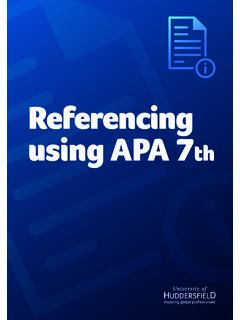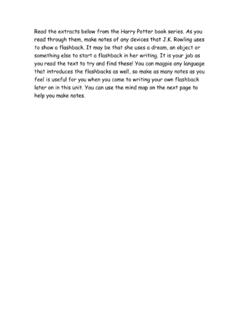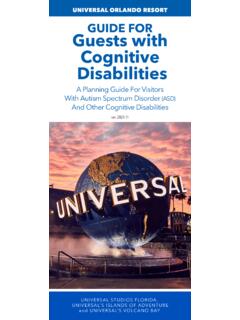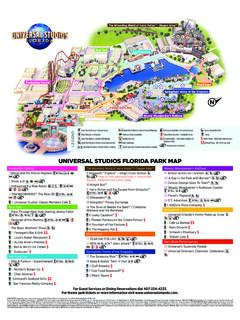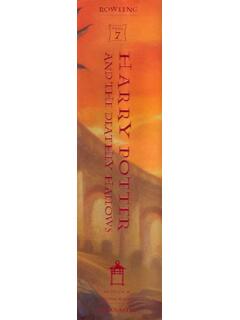Transcription of Referencing using APA 6th - Library Services
1 Referencingusing APA 6thUniversity of Huddersfield APA 6th Referencing Guide Last updated 03/03/2020 1 Contents Contents .. 1 Introduction .. 5 Why reference?.. 5 When do you need to reference? .. 6 Principle of Referencing .. 6 Principle of citation .. 7 Quoting, paraphrasing and summarising .. 7 Quoting .. 7 Paraphrasing .. 8 8 Citing more than one source to support an argument .. 8 Two or more citations by the same author .. 9 Secondary citing .. 9 Guidance for citing different numbers of authors .. 10 Reference list .. 11 What is a reference list? .. 11 Sample reference list .. 11 Formatting the 12 Digital object identifier (DOI).
2 12 Missing information .. 13 General principles to remember .. 14 Further help .. 15 Official APA 6th guidance .. 15 Help within the University of Huddersfield .. 15 1. Art .. 16 Artwork .. 16 Art online .. 16 Exhibition catalogue .. 17 Art exhibition .. 17 2. Books .. 18 Books with one or two authors .. 18 Books with three or more authors .. 19 Edited book .. 20 University of Huddersfield APA 6th Referencing Guide Last updated 03/03/2020 2 Chapter/ section of an edited book .. 21 ebook .. 21 A translated book .. 23 A book written in another language .. 24 Reference books: dictionary, thesaurus or encyclopedia.
3 24 Book review .. 26 The Bible/ Qu ran .. 27 3. Conference papers and poster sessions .. 28 Unpublished conference paper/ poster .. 28 Conference paper published online .. 29 4. Film, television, radio, video .. 30 Film .. 30 Television: single programme .. 31 Television: single episode of a television 31 Radio broadcast .. 32 Streamed video: YouTube .. 33 Podcast .. 33 5. Financial data .. 35 6. Images illustrations, photographs .. 36 Illustration /image/ photograph from a book .. 36 Illustration /image/ photograph in online collection .. 37 Image from a website .. 38 7. Journals, trade publications or magazines.
4 40 Journal article with one or two authors .. 40 Journal articles with three to seven authors .. 41 Journal article with eight or more authors .. 42 Magazine .. 43 8. Law .. 45 Cases (law reports) .. 45 Acts of Parliament .. 45 9. Leaflets, pamphlets, brochures .. 46 10. 47 Online maps: Google .. 47 Ordnance Survey map .. 47 Digimap Historic .. 48 Digimap Geology .. 48 University of Huddersfield APA 6th Referencing Guide Last updated 03/03/2020 3 Digimap Environment .. 49 11. Music/ sound recording .. 50 Album .. 50 Single track from album .. 50 Live performances .. 51 Music score .. 52 Streamed music.
5 53 12. Newspaper articles .. 54 Print newspapers .. 54 Online newspapers .. 55 13. Official publications .. 56 Government reports .. 56 Hansard .. 57 NICE guidelines/ guidance .. 58 14. Personal communication .. 59 Telephone calls/ emails/ personal interviews .. 59 Published interviews .. 59 15. Reports .. 61 Company reports .. 61 Market research 61 Ofsted reports .. 62 16. Specialist software .. 63 Software .. 63 Apps .. 63 17. Social media .. 65 Twitter .. 65 Facebook .. 66 Instagram .. 66 18. Standards and patents .. 68 Standard .. 68 Patent .. 68 19. Tables/ graphs and figures .. 70 20. Theatre .. 71 Live production.
6 71 Theatre programmes .. 72 21. Theses and dissertations .. 73 University of Huddersfield APA 6th Referencing Guide Last updated 03/03/2020 4 Printed dissertation/ thesis .. 73 Online dissertation/ thesis .. 73 22. Brightspace: lecture notes, module handbooks .. 75 23. Web page .. 76 Wikis .. 77 Blogs .. 77 University of Huddersfield APA 6th Referencing Guide Last updated 03/03/2020 5 Introduction When you have included anything from published sources in your work, you must acknowledge it fully and accurately by: identifying your sources, in a brief format, in the body of your written work (referred to as an in-text citation).
7 Providing a detailed list of your sources in alphabetical order at the end of your work (known as a reference list). The University Referencing style is APA 6th, published by the American Psychological Association. However, some departments use slightly varying rules, so please check your module handbook. Why reference? Referencing is important in all academic work for the following reasons: to show that you have researched/ read widely and found relevant information. to support any claims you have made through reference to an authoritative author on the subject. to enable readers of your work to trace the sources used and draw their own conclusions from the original works which you have cited.
8 Referencing is generally part of the mark scheme for your assignments. to avoid being accused of plagiarism. This is using someone else's work as your own without acknowledging it. If you do not acknowledge your source(s) you may be guilty of academic misconduct. For more details, please refer to the Regulations for taught students - Academic Misconduct University of Huddersfield APA 6th Referencing Guide Last updated 03/03/2020 6 When do you need to reference? You should acknowledge your source with a reference whenever you include: mention of a theory, fact, argument or viewpoint attributable to a specific person.
9 Statistics, examples or case studies. illustrations or musical examples. direct quotations/ paraphrase. Principle of Referencing The principle of Referencing is to answer these basic questions about your sources: There will not be specific guidance for every single source type. Sometimes you may need to find the source that is the closest fit . This may mean using elements from two source types. This APA blog is very useful for unusual reference types. Whowrote it?Whenwas it published?Whatis the title?Wherecan you find it?University of Huddersfield APA 6th Referencing Guide Last updated 03/03/2020 7 Principle of citation The principle of citation is to acknowledge the source in the body of the written work.
10 It provides information for the reader to locate the source in the reference list. Put the author s family name, followed by the year of publication. Do not include the author s initials in the citation. Include the author s initials in the reference list. If referring to the title of a book, official publication, music album, film within your text, use italics and capital letters for each significant word, harry potter and the Philosopher s Stone. For further rules on capitalisation and/ or punctuation, see the APA Blog. Quoting, paraphrasing and summarising Quoting Quoting is directly copying the original source and putting the text in quotation marks.
